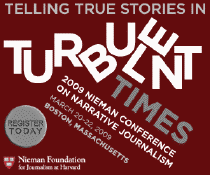Oops… didn’t mean to have Twitter-related entries two days in a row. Guess that’s just that way it works out sometimes. Don’t want everyone to think I’ve gone Twitter-mad, though I have become much more of a user than I was a few months ago.
Which reminds me that I’ve split my Twitter accounts into a personal one kat_hansen, KatCareerGal for career-management-related tweets and AStoriedCareer for storytelling tweets. If you’re more interested in storytelling than in what I had for breakfast, follow me at AStoriedCareer.
The past couple of weeks have not seen as strong trends in storytelling tweets as were out there the first couple of times I reported on what the Twitterverse is saying about storytelling. (As Twitterer @zamchick tweeted: “Storytelling in the time of twitter…’Twonce upon a twine…'”) But here are several items that received multiple mentions:
- Two story tools enjoyed some buzz. StoryTron, the complex software platform that I’ve blogged about before came out of beta testing and
 went public. The other buzzed-about tool is StoryTop, which has a very bare-bones Web site and no “About” page; the site’s main page says that StoryTop enables users to “create multi-page stories, drag and drop clip art to illustrate your story, add text in dialog boxes, create storytelling clubs with your friends, and share your stories with others.” Other sites review it as a tool for creating cartoon or comic-book-like stories. One gets the impression the tool is for children and teachers, but StoryTop itself is unclear about the audience it targets.
went public. The other buzzed-about tool is StoryTop, which has a very bare-bones Web site and no “About” page; the site’s main page says that StoryTop enables users to “create multi-page stories, drag and drop clip art to illustrate your story, add text in dialog boxes, create storytelling clubs with your friends, and share your stories with others.” Other sites review it as a tool for creating cartoon or comic-book-like stories. One gets the impression the tool is for children and teachers, but StoryTop itself is unclear about the audience it targets.  Enjoying well-deserved buzz was communications strategist, author, online publisher, and former CBS News correspondent David Henderson’s three-part storytelling series, Communications Leadership: Storytelling, A Great Story Has Legs, and What Does a Great Story Look Like?
Enjoying well-deserved buzz was communications strategist, author, online publisher, and former CBS News correspondent David Henderson’s three-part storytelling series, Communications Leadership: Storytelling, A Great Story Has Legs, and What Does a Great Story Look Like?
“We are all part of a storytelling culture in America,” Henderson notes in the first installment. Looking at storytelling from a journalist’s perspective, he observes that you do not need to be a journalist to tell your story, and if you put it out that, journalists just might pick it up. In part two, he asserts storytelling’s ability to energize organizational communications, such as shareholder/financial communications, internal communications, Web sites, blogs, social media, media relations and external relations, government and regulator relations, and new business development, among many other areas.
This nugget from part three summarizes Henderson’s response to the question, “What Does a Great Story Look Like?
“Storytelling is about life. It is about sharing the human experience, something that is a common thread that tends to touch and connect with something inside each of us … that makes us laugh, or perhaps cry, or maybe just contemplate. We listen to a great story, and we often will retell it to a family member, friend or colleague.”
- Memoir Spool, which sounds very much like New York’s The Moth,
 was much talked about in the past week because, though the San Francisco entity is described as “a monthly storytelling series held once a month,” it has apparently been on hiatus for awhile and returned on April Fool’s Day. While the group’s own site doesn’t offer much information, this piece in the SF Appeal online newspaper provides a mini-FAQ.
was much talked about in the past week because, though the San Francisco entity is described as “a monthly storytelling series held once a month,” it has apparently been on hiatus for awhile and returned on April Fool’s Day. While the group’s own site doesn’t offer much information, this piece in the SF Appeal online newspaper provides a mini-FAQ. - Much tweeted about was the news that (cable network) AMC is about to offer branded storytelling — “themed movie nights, some potential new TV series and a new marketing message: ‘Story matters here.'” These tweets annoyed me, however, because they linked to a Wall Street Journal article that one had to pay for a subscription to completely read. Seriously, WSJ?
 Finally, some mini-buzz for the 2009 Nieman Conference on Narrative Journalism in March, in which speakers, according to Columbia Journalism Review‘s Megan Garber, admitted the business model of newspapers is broken but still presented an upbeat look at narrative journalism. ” Narrative is journalism’s future …” one speaker declared.
Finally, some mini-buzz for the 2009 Nieman Conference on Narrative Journalism in March, in which speakers, according to Columbia Journalism Review‘s Megan Garber, admitted the business model of newspapers is broken but still presented an upbeat look at narrative journalism. ” Narrative is journalism’s future …” one speaker declared.
